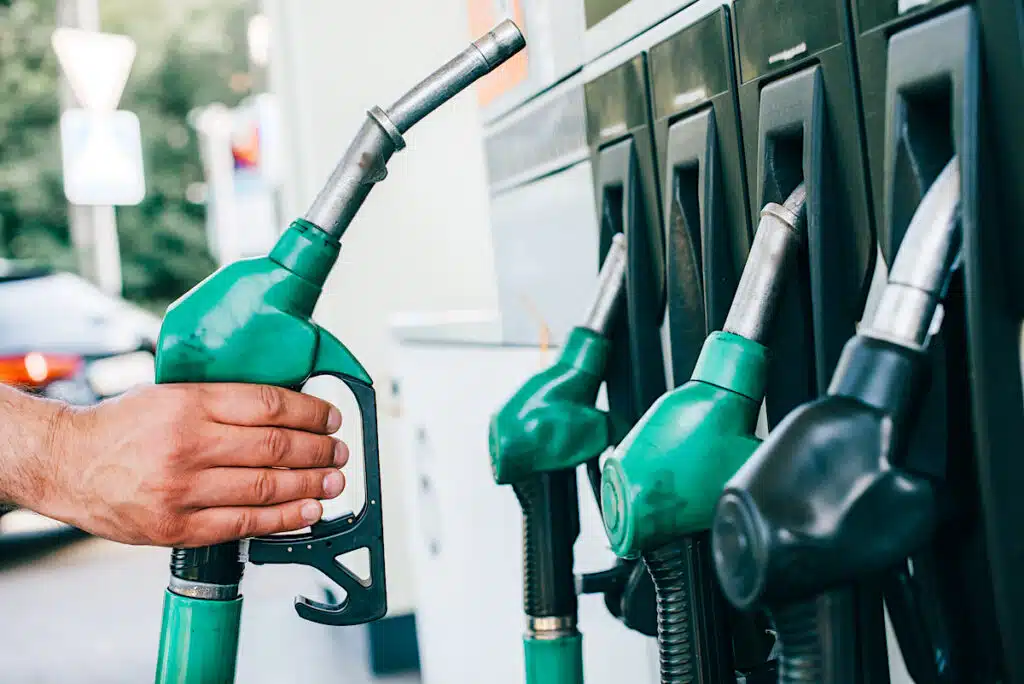Are you looking at fuel prices and wondering how to save money at the gas pump while on your next RVing adventure?
Fuel prices ebb and flow due to many factors. However, there are ways to save money on your fuel costs regardless of current prices at the pump when filling up your motorhome or your tow vehicle.
Here is our list of ways to save your gas and diesel expenditure and ways to be a more efficient RV driver.

Don’t Travel With A Full Fresh Water Tank
Reducing the overall weight you are carrying when RVing will directly impact your fuel costs.
One easy way to reduce your weight is to not travel with a full fresh water tank. Unless you are specifically RVing to boondock at a location with no hook-ups or access to freshwater, there is really no reason to carry the extra weight of a full fresh water tank.
One gallon of water weighs approximately 8.4 pounds.
When you consider many RV’s have fresh water tanks that hold 30 – 50 gallons, that equates to approximately 420 pounds of additional weight your motorhome or tow vehicle will require additional fuel to move down the road.
If you are traveling between destinations where you will have partial or full hookups at your campsites, consider only placing a few gallons of fresh water in your tank in the event you need to stop along the way to refill a water bottle or use your RV’s bathroom.
We suggest no more than 5 gallons of water in your fresh tank unless you are traveling to a boon docking location.
Reduce The Amount of Gear You Bring
Many RVer’s feel the need to bring everything that is in their kitchen cabinets and garage at home when RVing.
While the convenience of bringing ‘everything’ with you is a nice-to-have, the weight of all of that gear adds up quickly.
When RVing, extra weight means more fuel burned, as well as more wear and tear on your motorhome or tow vehicle’s engine.
In addition, you very quickly run the risk of maxing out the weight capacity of your RV.
For your next RV trip, consider bringing only the essential gear tailored to that specific RV outing.
For example, if you know you are only RVing for a two week period to the beach, ask yourself do you really need the extra five flannel shirts, boots, climbing gear, two winter jackets, five cords of firewood, full set of grandma’s china, every kitchen utensil in your drawer, and your entire set of Craftsmen tools?
No, no you don’t.
Bring only what you need for the trip and consider using paper plates, plastic cutlery, lightweight cups that can be washed, only enough clothing for the trip, gear that is specific to the destination, and only enough tools to keep your rig in operating order.
Reducing the overall weight you carry will greatly reduce your fuel costs.
See how much we spent on gas during a 30-day RV itinerary in our YouTube video below:
Avoid Traveling On Windy Days
While many RVers want to travel on the open road without any restraints or being tied down with plans, we do suggest at least one travel planning step that can help save on your fuel costs.
Planning your RV schedule to avoid windy conditions on travel days is not only a safer way to travel, it will also save you money at the gas station.
Yes, you want to avoid inclement weather. You also want to avoid traveling on beautiful, clear days that have heavy cross winds or head winds that will reduce your fuel mileage.
A day or two prior to your next travel day, we suggest using weather apps and websites such as AccuWeather and Weatherunderground that provide you more information and forecasts beyond temperature and humidity.
These phone apps and websites also provide weather information that include wind predictions for your travel path.
Stay Longer At Your Travel Stops Rather Than Moving Often
A great way to reduce your fuel expenditure when RVing is to increase the number of days you spend at your stops during your RV trip.
While it is great to maximize the ability to see as much as possible during your getaway (trust us, we understand that!), consider staying longer at your various travel stops rather than traveling more miles.
Increasing your travel stops by two or more days will reduce your overall fuel consumption exponentially.
This may require you to take a few destinations or stops off your itinerary, however, it also gives you the opportunity to see more at each location while saving you money.
Go To Destinations With Shuttles
You want to RV, but the fuel costs seem to keep rising. So you’re thinking of not traveling much at all this year. Sound familiar?
Then consider planning your next RV trip to include stops along the way or your final destination that have shuttles or mass transit systems.
Having the ability to stay in or near a destination that already has a shuttle service will help reduce the need to utilize your towed vehicle, if you have a motorhome, or using your tow vehicle if you have a travel trailer.
Great places such as many of the National Parks, like Zion National Park, offer shuttle services within the park. You can save fuel costs by simply making one trip there and back, use their internal shuttle service, and not rely on burning your gas to get around the park.
Other great destinations have their own internal or mass transportation systems include:
- Walt Disney World Resort
- Universal Orlando Resort
- The Metro in Washington, D.C.
- The subway in New York City
- The Loop in Chicago
The minimal cost of using mass transit systems at a destination will most often be less than the cost of burning gas in your personal vehicle.
Maintain Proper Tire Pressure
Maintaining proper tire pressure for your motorhome and your tow vehicle is not only critical to the safety of your towing experience, but it will affect your average miles per gallon of fuel used when RVing.
Proper tire pressure on your RV, travel trailer, and tow vehicle will help prevent blowouts.
If your tire pressure is too low, it can affect your overall fuel per mile consumption.
The U.S. Department of Energy states that for every 1-psi drop in pressure, you can expect your gas mileage to lower by 0.4 percent.
✳️ Learn More About Proper Tire Pressure When Towing A Travel Trailer
Every individual tire, regardless of the manufacturer, has its own unique operating tire pressure engineered by the tire manufacturers for optimum use.
Under inflation and over inflation of your tires can greatly affect a safe towing experiencing and potentially take more money out of your RV fuel budget.
Drive 3 to 5 Miles Per Hour Slower
If you are like us, after thousands of miles towing our travel trailers, we have found the sweet spot – in terms of miles per hour – of our tow vehicle of speed vs. saving fuel.
Getting to know your motorhome’s or tow vehicle’s optimum speed for towing that, if exceeded, begins to use more fuel is important in saving you money at the gas pump.
Over the years of towing two different size travel trailers with the same tow vehicle, we have discovered an optimum max MPH when towing on the highway that will reduce our fuel usage.
This will vary greatly by vehicle, but consider reducing your speed limit 3 to 5 miles per hour and you will notice a difference. You will still be able to keep up with other vehicles at-speed on the highway, but you will save fuel.
Comparison Shop Fuel Prices
Another great way to save a few dollars each time you fuel up your RV or tow vehicle is to comparison shop amongst gas stations.
When given the option, try finding a gas station ahead of time – before you stop for fuel – by using your smartphone.
Apps on your smartphone such as GasBuddy are a great way to comparison shop multiple gas stations at once prior to arriving. On the GasBuddy app, which is available for Apple and Android smartphones, you can search via their map nearly any location within the U.S.
By zooming in to a particular location, you will be able to see in near realtime the various gas stations current prices.
Saving a few dollars each time your fuel up your RV will add up quickly over the duration of your RV adventure, especially when you have fuel tanks that can hold up to 100 gallons.
Which puts more money back in your pocket for that pecan log roll or salt water taffy you seem to purchase every trip.
Fill Up Your Fuel Tank In Less Popular Areas
Unless you are running on fumes and need to stop at the nearest gas station, consider stopping at gas stations in less populated areas away from city-centers and crowded exits.
Consider stoping at exits or gas stations that are on the edge of towns or populated areas. These usually have competitive fuel prices where you are not paying the ‘convenience premium’ for the gas stations near ‘everything’.
This is another great way to use your fuel gas price smartphone apps, like GasBuddy, to assist you with this search ahead of time for the best gas price near you.
Diesel Fuel Program
For RVers with diesel engines, either diesel motorhomes or tow vehicles, you may want to consider enrolling and obtaining a TSD/EFS Fuel card.
The fuel card program offers diesel fuel discounts to anyone who frequently purchases diesel fuel, such as truckers and RVers who travel many miles throughout the year.
RVer’s with a diesel motorhomes or diesel truck owners can apply for this program to start saving big on your fuel bills.
TSD Logistics is a bulk-freight transport-trucking company that offers their fuel program for discounted diesel fuel prices, similar to what their truckers utilize. The program is run by WEX Worldwide, a global payment provider.
The program works by you applying for the discount fuel card online. Once approved, you will receive the physical card. Then you will want to download the accompanying smartphone app which includes a fuel stop locator you can use along your travel route. Your discount at the pump can be tracked and monitored for your use. To apply for this program go to the TSD Logistics website.
